Trade names Invirase, Fortovase MedlinePlus a696001 ATC code J05AE01 (WHO) CAS ID 127779-20-8 | AHFS/Drugs.com Monograph Pregnancycategory B1 (Australia) Molar mass 670.841 g/mol Protein binding 98% | |
 | ||
Bioavailability ~4% (without ritonavir boosting) | ||
Saquinavir meaning
Saquinavir, sold under the brand names Invirase and Fortovase, is an antiretroviral drug used together with other medications to treat or prevent HIV/AIDS. Typically it is used with ritonavir or lopinavir/ritonavir to increase its effect. It is taken by mouth.
Contents
- Saquinavir meaning
- Medical uses
- Side effects
- Bioavailability and drug interactions
- Mechanism of action
- History
- Cost
- Formulations
- References

Common side effects include nausea, vomiting, diarrhea, and feeling tired. More serious side effects include problems with QT prolongation, heart block, high blood lipids, and liver problems. It appears to be safe in pregnancy. It is in the protease inhibitor class and works by blocking the HIV protease.
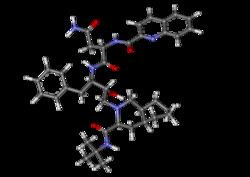
Saquinavir was first sold in 1995. It is on the World Health Organization's List of Essential Medicines, the most effective and safe medicines needed in a health system. As of 2015 it is not available as a generic medication in the United States and is expensive. The wholesale cost in the developing world is about 4.50 USD per day.

Medical uses
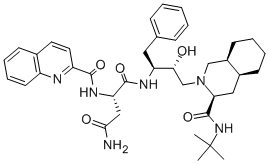
Saquinavir is used together with other medications to treat or prevent HIV/AIDS. Typically it is used with ritonavir or lopinavir/ritonavir to increase its effect.
Side effects
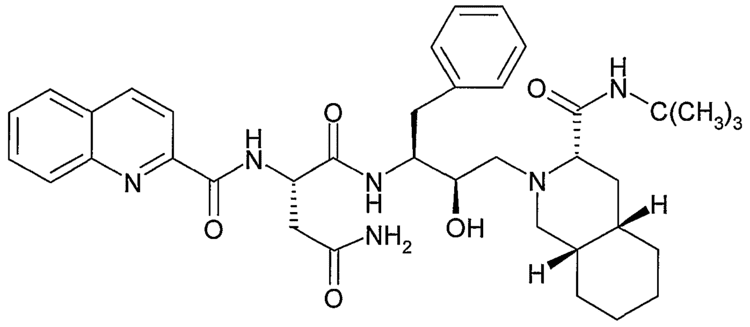
The most frequent adverse events with saquinavir in either formulation are mild gastrointestinal symptoms, including diarrhea, nausea, loose stools & abdominal discomfort. Invirase is better tolerated than Fortovase.
Bioavailability and drug interactions
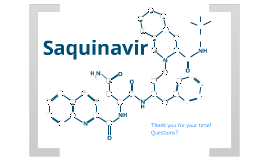
Saquinavir, in the Invirase formulation, has a low and variable oral bioavailability, when given alone. The Fortovase formulation at the standard dosage delivers approximately eightfold more active drug than Invirase, also at the standard dosage.
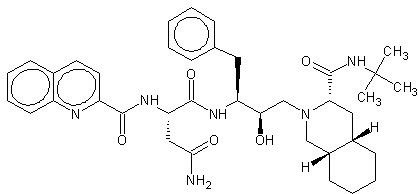
In the clinic, it was found that the oral bioavailability of saquinavir in both formulations significantly increases when patients also receive the PI ritonavir. For patients, this has the major benefit that they can take less saquinavir, while maintaining sufficient saquinavir blood plasma levels to efficiently suppress the replication of HIV.
The mechanism behind this welcome observation was not directly known, but later it was determined that ritonavir inhibits the cytochrome P450 3A4 isozyme. Normally, this enzyme metabolizes saquinavir to an inactive form, but with the ritonavir inhibiting this enzyme, the saquinavir blood plasma levels increased considerably. Additionally, ritonavir also inhibits multidrug transporters, although to a much lower extent.
Unlike other protease inhibitors, the absorption of saquinavir seems to be improved by omeprazole.
Mechanism of action
Saquinavir is a protease inhibitor. Proteases are enzymes that cleave protein molecules into smaller fragments. HIV protease is vital for both viral replication within the cell and release of mature viral particles from an infected cell. Saquinavir binds to the active site of the viral protease and prevents cleavage of viral polyproteins, preventing maturation of the virus. Saquinavir inhibits both HIV-1 and HIV-2 proteases.
History
Saquinavir was developed by the pharmaceutical company Roche. Saquinavir was the first protease inhibitor (and sixth antiretroviral) approved by the Food and Drug Administration (FDA). Within 2 years of its approval, and that of ritonavir 4 months later, annual deaths from AIDS in the United States fell from over 50,000 to approximately 18,000. The manufacturer, Roche, requested and received approval of Invirase via the FDA's "Accelerated Approval" program, a process designed to speed drugs to market for the treatment of serious diseases. This decision was controversial, amid disagreement between AIDS activists over the benefits of thorough testing versus early access to new drugs.
It was approved again on Nov 7, 1997 as Fortovase, a soft gel capsule reformulated for improved bioavailability. Roche announced in May 2005 that, owing to reduction in demand, Fortovase would cease being marketed early in 2006 in favour of Invirase boosted with ritonavir.
Cost
As of 2015 it is not available as a generic medication and is expensive. The wholesale cost is about 4.50 USD per day.
Formulations
Two formulations have been marketed:
